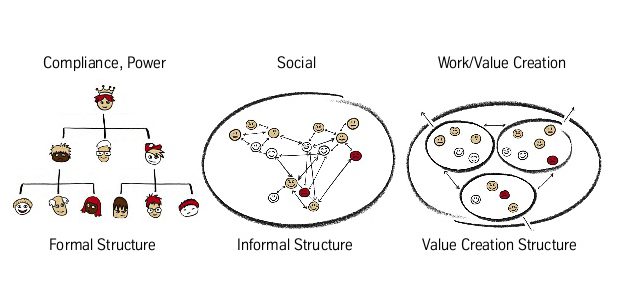A simple view of organization structure is management and workers. The reality is three structures: formal controls, informal collaboration, and value creation networks.
Cultivate Formal Controls, Informal Collaboration, and Value Creation Networks
“Software companies have parallel career tracks for engineers and managers. This creates two overlapping status hierarchies.”
Slava Akhmechet (@spakhm) in “Parallel Tracks“
I agree with Niels (@NielsPflaeging) in “organize for complexity” who argues for three overlapping networks: control, expertise, and social. For highlights see “7 Insights from Organize or Complexity” for detail see Organize for Complexity, for an overview see slide 34 of Pflaeging’s Keynote at 2015 HR Congress that shows:
- Formal structure: the organization chart manages compliance and power to spend, hire, fire.
- Informal Structure: the white space on the organization chart.
- Work/Value Structure: the workflows that the company uses to create value for customers.

In 2020, Pflaegling wrote a good short article on his model: “Linking Theory and Practice.”
Akhmechet’s “Parallel Tracks” article is a grim zero-sum view of what it’s like to work in company. Healthy cities and healthy organizations are semi-lattices, not trees, where there are overlapping connections and networks. The work/value structure is a community of practice, not a strict hierarchy among them. Management is much the same way. Meetings that only serve that status needs of managers are a poor use of time. But other meetings can have value, see for example “Butterflies vs. Geniuses.” Unless you are strictly committed to command and control over market solutions and social processes, leaders should encourage overlap–this enables coordination, consultation, collaboration, situational leadership, and competition–not a single command hierarchy.
Two books that outline the risks of a single corporate hierarchy are Moral Mazes by Robert Jackall and The Oppressed Middle by Earl Shorris. Two that outline a more positive view are “Leadership is an Art” by Max Dupree and “The Leadership Challenge” by Barry Posner and James Kouzes.
Related Blog Posts
- 7 Sets of Insights from “Organize for Complexity” by Niels Pflaeging
- The Shape of Firms to Come: Key Values and Architectural Philosophy
- The Business is Everyone’s Business
- The Business is Everyone’s Business (Part 2)
- Innovation Principles from Ken Iverson’s “Plain Talk”
- Combine Clear Goals with Delegation Based on Expertise for High Impact
I find Simon Sinek’s writings, in particular “Start with Why” and “Leaders Eat Last” very compelling on the topic of the obligations of leadership. I have blogged about him several times

Pingback: Quotes for Entrepreneurs Collected in October 2020 - SKMurphy, Inc.